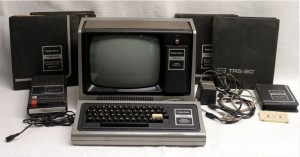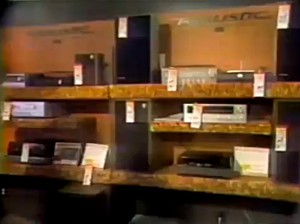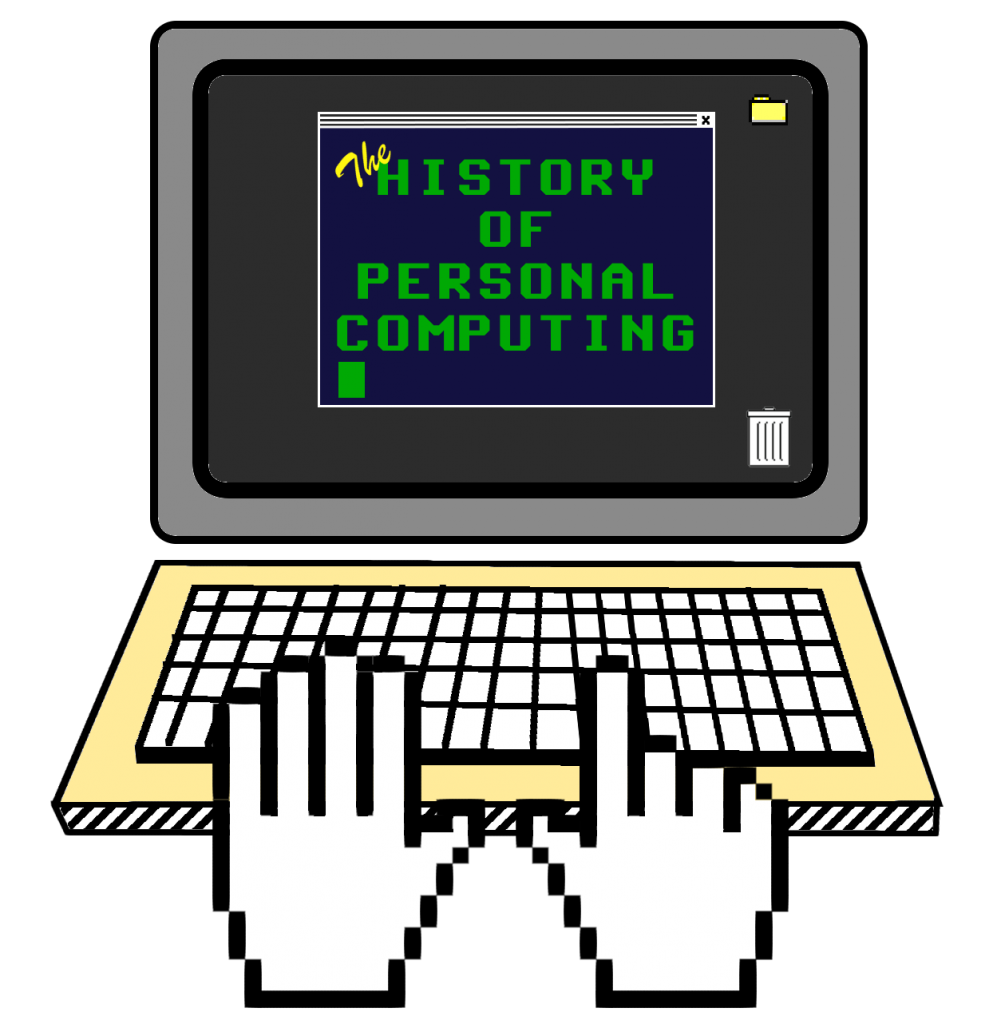TRS-80 Model I
There were three of what we consider the first real consumer computers, or “out-of-the-box” micros, all released in 1977. These were arguably the first personal computers that could be purchased, brought home, taken out of their boxes, setup, and then used in some productive way – right away. the computer in this post is the second of the computer for the masses, the Tandy Radio Shack TRS-80 Micro Computer System, later to be called the TRS-80 Model I.
| Listen to our podcast episode about the TRS-80 Model 1 computer here |
Now, picture this if you will…
It’s the holiday season, the last shopping days before Christmas, and you’re going to your local Radio Shack store to check out the latest CB radios for the next catalog year. You head into that familiar looking woodgrain adorned store with the orange carpet and something with a stark, contrasting non-earthy grey color tone catches the corner of your eye.
You say to yourself, “What is that, a TV?”
You notice the black & white screen, and it looks like a TV, but it has no knobs on it. All you see on the screen is the word “READY” followed by a greater-than sign. Below the TV lies what looks like a typewriter keyboard, but the paper platen is nowhere in sight. Almost on cue, the perm-haired, mustachioed, polyester suited salesperson introduces himself, then proceeds to introduce you to the brand new TRS-80 home computer!
Radio Shack – The Company
Radio Shack is an old company, originally founded in 1921 by two brothers, Theodore and Milton Deutschmann. They wanted to sell equipment to the early amateur radio hobbyists in the emerging field of ham radio. They opened a retail store and mail-order operation in downtown Boston and chose the name “Radio Shack,” as it was the term for a small, wooden structure that housed a ship’s radio. Radio Shack issued its first catalog in 1939, where it listed ham radio equipment, thousands of parts and even some entertainment high-fidelity radios. By the mid-1950s, they began selling their own private-label products under the brand name Realistic. Unfortunately, the company fell on hard times in the 1960s and was almost bankrupt, when Charles Tandy saw the potential of Radio Shack and retail consumer electronics. His company specialized in leather goods and had had a banner year in 1961. In 1962, he purchased the company, which included nine retail stores, for $300,000. By the time the TRS-80 Model I was arriving in stores, there were over 3000 Radio Shacks, with related stores in other parts of the world. Sadly, Charles Tandy passed away unexpectedly only a year after the release of Radio Shack’s microcomputer. He died on November 4, 1978. He was only 60 years old.
TRS-80 – The Computer
The TRS-80 was first introduced to the public in August 1977. Since Radio Shack had a fiscal-year-based catalog, typically effective from September of the current year to August of the next, the computer was presented to consumers in the 1978 Radio Shack catalog. Catalog purchasers started receiving their systems in September, and the micros landed in stores in December of 1977.
At its introduction, the specifications of the TRS-80 were as follows:
- Z-80 Microprocessor running at 1.77MHz
- 32 or 64 character display (software programmable) with 16 lines
- 128×48 pixel graphics
- 4K RAM, expandable to 56K
- 4K ROM
- 53-key keyboard
- The Model I had no sound hardware. Square wave tones could be produced by outputting data to the cassette port and plugging headphones or an amplifier into the Data Out line. Some games used this ability for sound effects.
- The first models of the Model I also had problems reading from the cassette drives. Tandy eventually offered a small board which was installed in a service center to correct earlier models. The ROMs in later models were modified to correct this.
The starting price for the TRS-80 was $399.95. That was without the monitor. To make a complete computer kit, you would need to include the $199.95 monochrome NTSC monitor and the $49.95 Realistic CTR-41 cassette tape recorder and connecting cable. Together, these components cost $649.85, but if you bought them all together, you could buy the TRS-80 system for $599.95.
Like the Apple II, which grew from its Apple I cousin comprised of a kludged together collection of miscellaneous parts, the TRS-80 has its origins in a homebrewed design of sorts. The original prototype for the TRS-80 was wirewrapped. To an electronics hobbyist, wirewrapped meant that every lead from every part was wrapped with a length of thin wire with its insulation stripped at one end, having the other end of the wire equally stripped and placed on another part’s lead as the schematic required.
You could imagine how cluttered such a computer board would look with all of these wires going in seemingly random directions. But on February 2nd, 1977, such a contraption (secretly stored under a table, behind a table skirt) was used to demonstrate the TRS-80 for the first time to Charles Tandy himself and his top level executives.
TRS-80 – The Legacy
Radio Shack sold over 10,000 TRS-80 Model Is in its first one and a half months of sales, and over 200,000 during the product’s lifetime! By 1980 Kilobaud Microcomputing estimated that Radio Shack was selling three times as many computers as Apple Computer, with both companies ahead of Commodore.
The original TRS-80 microcomputer essentially lived on through three more models, as the Model III, Model 4 and the portable Model 4p. Introduced in 1980, the Model III included improvements like a better keyboard with built-in lower case, a faster Z-80 processor at 2.03 MHz, and a 1500-baud cassette interface. With the introduction of the Model III, the Model I was discontinued as it did not comply with new FCC regulations. The Model 4 was released in 1983 and included the capability to run CP/M. It also had a faster 4 MHz Z80A CPU.
The Model II, released in 1979, was not an upgrade to the Model I, but an entirely different system. It was sold as a professional business machine and included many advanced features which made the Model I seem absolutely primitive.
The TRS-80 name was used in a number of later, unrelated computers by Radio Shack, including the II, 12, 16, Color Computer and Pocket Computer.



